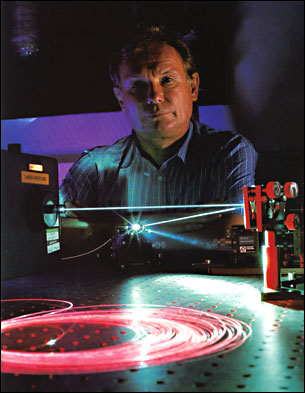
Southampton Opening Center for Photonics, Electronics
SOUTHAMPTON, England, Sept. 5, 2013 — The largest photonics and electronics institute in the UK officially opens Sept. 12 at the University of Southampton.
The Zepler Institute, a multidisciplinary center, will allow more than 300 researchers in photonics, advanced materials and quantum technologies to build on the university's pioneering discoveries in photonics and electronics for communications. Research conducted at the university's Optoelectronics Research Centre (ORC) enabled development of the first low-loss optical fiber and the invention of the erbium-doped fiber amplifier (EDFA), key to the development of the Internet and today's high-speed telecommunications networks.
"Every time you use the Internet, your mobile phone or an ATM, you are using technology developed at Southampton," said professor Dame Wendy Hall, dean of physical and applied sciences.

Professor Sir David Payne is director of the University of Southampton's new Zepler Institute for research in photonics, electronics and advanced materials. ©University of Southampton.
The institute, — named for professor Eric Ernest Zepler, a radio receiver development pioneer who founded the Department of Electronics and Computer Science at University College Southampton (now the University of Southampton) in 1947 — will focus on three broad research themes: advanced materials and nanotechnology, electronics and photonics.
It will provide a collaborative environment for research, including ultrahigh bandwidth communication technologies, biophotonics for point-of-care diagnostics, and fundamental research into quantum devices and technologies, in collaboration with the university's Physics, Quantum Light and Matter group, the university said.
“The formation of the Zepler Institute ensures that University of Southampton continues to make pioneering breakthroughs and discoveries that will meet society’s global communication challenges. It also puts us in a leading position to develop the future of the Internet," Hall said.
Directing the institute is professor Sir David Payne, ORC director and a fiber optics pioneer who led the team that developed the EDFA. Payne will deliver a special lecture, "50 Years of Photonics at the University of Southampton," to mark the institute's opening and to celebrate his knighthood for services to photonics. (See: Queen Knights Fiber Laser Pioneer)
The event also will feature a lecture by Vint Cerf, vice president and chief Internet evangelist for Google, who is considered one of the "fathers" of the Internet.
The celebration starts at 3 p.m. with researchers from across the Zepler Institute showcasing their work and facilities. The lectures, which begin at 5 p.m. at the university's Highfield campus, are free and open to the public, although space is limited.
The lectures will be streamed live at www.zeplerinstitute.com
For more information, visit: www.soton.ac.uk
Published: September 2013